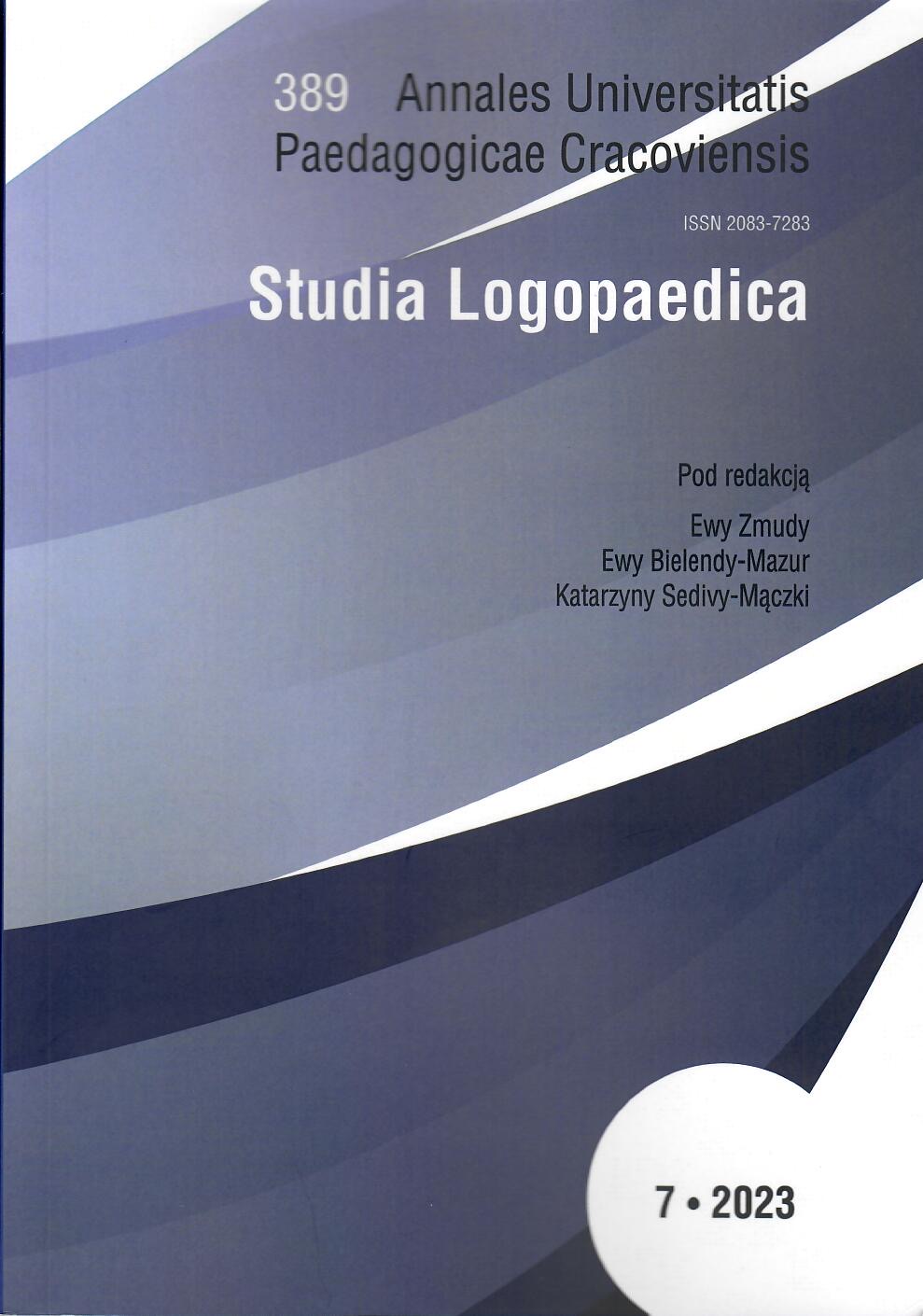Znaczenie obręczy barkowej u pacjenta z zaburzeniami miofunkcjonalnymi
DOI:
https://doi.org/10.24917/20837283.7.5Słowa kluczowe:
fizjoterapia, zaburzenia miofunkcjonalne, trakt orofacjalny, obręcz barkowa, wady postawyAbstrakt
Niniejszy artykuł przedstawia relacje anatomiczne oraz możliwość występowania wpływu niższych segmentów ciała na funkcjonowanie traktu orofacjalnego. Opisuje pracę opartą na terapii ruchowej z przykładowym pacjentem logopedycznym w gabinecie fizjoterapeutycznym. Ukazuje możliwość współpracy interdyscyplinarnej przyczyniającej się do optymalizacji osiągnięć pacjenta w zakresie realizacji celów terapeutycznych.
Bibliografia
Alghadir A.H., Zafar H., Iqbal Z.A. (2021). Effect of tongue position on postural stability during quiet standing in healthy young males. Somatosensory & Motor Research, 32(3), 183–186.
Google Scholar
Álvarez Solano C., González Camacho L.A., Castaño Duque S.P., Cortés Velosa T., Vanoy Martin J.A., Chambrone L. (2020). To evaluate whether there is a relationship between occlusion and body posture as delineated by a stabilometric platform: A systematic review. Cranio, 24, 1–12.
Google Scholar
Chaves T.C., Turci A.M., Pinheiro C.F., Sousa L.M., Grossi D.B. (2014). Static body postural misalignment in individuals with temporomandibular disorders: a systematic review. Braz J Phys Ther, 18(6), 481–501.
Google Scholar
Comerford M., Mottram S. (2016). Kinetic Control. Ocena i reedukacja niekontrolowanego ruchu. Wrocław: Edra Urban & Partner.
Google Scholar
Diéguez‑Pérez M., Fernández‑Molina A., Burgueño Torres L. (2024). Influence of the mandibular position on various postural anatomical segments. CRANIO®, 42(2), 223–231.
Google Scholar
Kaur P., Sharma C. (2022). Role of Physiotherapy in Management of Orofacial Diseases: A Brief Review. Journal of MAR Dental Sciences, 5, 1.
Google Scholar
Korbamcher H., Koch L.E., Kahl‑Nieke B. (2005). Orofacial, myofunctional disorders in children with asymmetry of the posture and locomotion apparatus. International Journal of Orofacial Myology and Myofunctinal Therapy, 31, 26–38.
Google Scholar
Lee Y-J., Park J-H., Lee S-J., Ryu H-M., Kim S-K., Lee Y-J., Yoon H-M., Jang S-H., Song C-H., Kim C-H. (2017). Systematic Review of the Correlation Between Temporomandibular Disorder and Body Posture. Journal of Acupuncture Research, 34(4), 159–168.
Google Scholar
Miçooğulları M., Yüksel İ., and Angın S. (2024). Efficacy of Scapulothoracic Exercises on Proprioception and Postural Stability in Cranio‑cervico‑mandibular Malalignment:A Randomized, Double‑blind, Controlled Trial. Journal of Back and Musculoskeletal Rehabilitation, (Pre‑press), 1–14.
Google Scholar
Neumann D.A. (2017). Kinesiology of the Musculoskeletal System. Foundations for Rehabilitation. Amsterdam: Elsevier.
Google Scholar
Nota A., Tecco S., Ehsani S., Padulo J., Baldini A. (2017). Postural stability in subjects with temporomandibular disorders and healthy controls: A comparative assessment. J Electromyogr Kinesiol, 37, 21–24.
Google Scholar
Paris‑Alemany A., Proy‑Acosta A., Adraos‑Juárez D. et al. (2021). Influence of the Craniocervical Posture on Tongue Strength and Endurance. Dysphagia, 36, 293–302.
Google Scholar
Paulsen F., Wascke J., Sobotta J. (2019). Atlas anatomii człowieka. Głowa, Szyja i układ nerwowy. Wrocław: Edra Urban & Partner.
Google Scholar
Saccomanno S., Pirino A., Bianco G., Paskay L.C., Mastrapasqua R., Scoppa F. (2021). Does a short lingual frenulum affect body posture? Assessment of posture in the sagittal plane before and after laser frenulotomy: a pilot study. J Biol Regul Homeost Agents, 35(3 Suppl. 1), 185–195.
Google Scholar
Sakaguchi K., Mehta N.R., Abdallah E.F., Forgione A.G., Hirayama H., Kawasaki T., Yokoyama A. (2007). Examination of the Relationship Between Mandibular Position and Body Posture. CRANIO®, 25(4), 237–249.
Google Scholar
Salkar R.G., Radke U.M., Deshmukh S.P., Radke P.M. (2015). Relationship between temporomandibular joint disorders and body. International Journal of Dental and Health Sciences, 2(6), 1523–1530.
Google Scholar
Siudak A., Prażak J. (2023). Zaburzenia miofunkcjonalne w kontekście rozwoju motorycznego dziecka – studium przypadku. Logopedia, 52(2), 211–224, https://www.logopedia-ptl.pl/index.php/logopedia/article/view/261 (dostęp: 30.12.2023).
Google Scholar
Sodhi A., Nair P.K., Hedge S. (2014). Physiotherapy: Key to the kinetics of orfacial musculature. Journal of Indian Academy of Oral Medicine & Radiology, 26, 419–424.
Google Scholar
Souza J.A., Pasinato F., Corrêa E.C., da Silva A.M. (2014). Global body posture and plantar pressure distribution in individuals with and without temporomandibular disorder: a preliminary study. J Manipulative Physiol Ther, 37(6), 407–414.
Google Scholar
Wright E.F., Domenech M.A., Fischer J.R. (2000). Usefulness of posture training for patients with temporomandibular disorders. JADA, 131, 203–210.
Google Scholar


